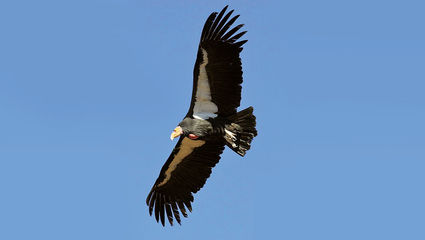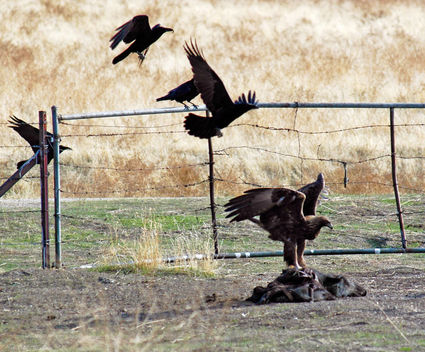Just inches away from California Condors and Golden Eagles
Mountain Tales: First-hand stories of life in Tehachapi
January 4, 2020
I was involved in the early days of the California Condor Recovery program, prior to the capture of all the remaining birds in 1987 in a last-ditch (and ultimately very successful) effort to prevent their extinction. We suspected that lead poisoning was one of the leading causes of condor mortality, caused by ingesting bullet fragments from carcasses and hunter's gut piles.
We wanted to take blood samples and check their lead levels, but there were only 22 birds in existence and the U.S. Fish and Wildlife Service didn't want to take a chance on harming one of the few remaining birds by capturing them, so as a substitute we were given permission to trap and take blood samples from Golden Eagles, which are numerous and also frequently feed on carrion, often alongside condors.
We made a pit trap in the Tehachapi Mountains on Tejon Ranch property. It was modified from an American Indian design, in which a man would dig a hole big enough to lie in, then cover the top with willow branches and hide inside, baiting the trap above with a carcass or a live rabbit.
When an eagle landed to feed, the Indian would reach out and grab it by the legs. A raptor's talons are its main weapon, so when you grab their feet, they try to fly away rather than pecking your hands. Our pit trap was bigger and dug into a slope so we could sit rather than lie down, but the principle was the same. We'd bait it with a stillborn calf carcass from a San Joaquin Valley dairy, then climb inside and wait.
When an eagle landed on the trap by the carcass, we'd wait until it started eating and then catch it. After we had taken a blood sample, we'd put a numbered aluminum band on one leg so that we could identify it in the future. As the project continued, we caught and banded more and more eagles.
When an eagle came in that already had a leg band, we'd write down the number of its band for our records. The eagles would be so occupied with feeding that if the number wasn't completely visible, you could actually reach a hand slowly out of the trap and rotate the leg band a little so that you could read the entire number. They wouldn't even notice.
Sometimes one of the remaining condors would spot the carcass and land to feed, and then the eagle project came to an abrupt halt until the condor was finished eating. They have a nine-foot wingspan and stand more than three feet tall, so the eagles would always yield to them. You knew you might as well sit back and relax when a condor was feeding, because it wouldn't leave until it was full and condors can eat a lot. Their bills are just like sharp shears, and they can cut right through a hide like a surgeon to expose the meat underneath.
As the apex carrion feeder, that's one of the roles they perform in the wild – they can scissor their way through a tough hide that the smaller scavengers like ravens, eagles and turkey vultures can't penetrate. The condors would gorge on a calf carcass and eat so much they couldn't fly – they'd waddle off to the side and sit there and digest.
Our research proved that eagles did in fact have elevated lead levels in their blood, sometimes quite high, and the decision was made to trap all the remaining condors and captive-breed them out of danger. The success of the program speaks for itself.
– Dick Anderson
Dick Anderson is a highly respected wildlife biologist specializing in raptors. He has led many wildlife research efforts, including a five-year Department of Energy program in Tehachapi studying avian mortality caused by wind turbines. At present, there are nearly 500 California Condors in the world.







